Written aboard the Longship Skadi on her voyage through Holland and Belgium with stops in Amsterdam, Kinderdijk, Antwerp, Bruges, Veere, Hoorn, and Arnhem. Thanks to Viking River Cruises for inviting us along and providing this adventure! As always, all opinions are our own.
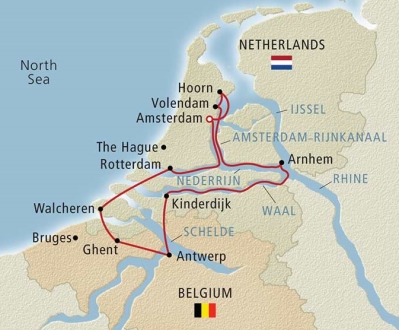
Spring has sprung and we’re ready to embrace it fully!
And what better way to celebrate the new season than to head to the flower capital of the world – Holland!
But that’s not all kids – we’ll be sailing into Belgium too!
Join us LIVE as we spend 10 days in the Low Countries…
Day One: Arriving in Amsterdam and Meeting Skadi
Morning: Beam me up Skadi
This is our second time aboard the Longship Skadi – the first time was on our fabulous Christmas Cruise along the Danube. We’re a couple of staterooms away from this one…
…but it’s every bit as wonderful!
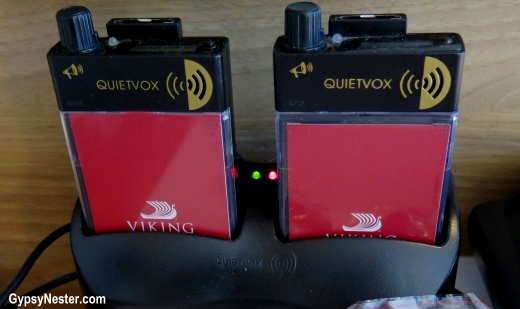

Skadi’s top deck – love the kitchen garden!
We’re headed out for a walking tour of Amsterdam – geared up with our QuietVox that charges in our stateroom between tours.
With these little radio boxes attached to headphones, we have the freedom to roam a bit and take photos without missing a word our guide has to say.
Afternoon: Water and wonkiness
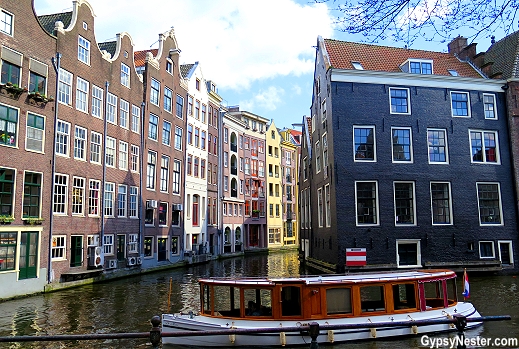
Amsterdam has a distinct architectural style; space along the waterways is limited so builders chose to make narrow, deep houses two or three times as long as they are wide, standing three or four stories high.

We can’t help but notice the propensity for these old buildings to slant every which way.

The land is very soft, so wooden pilings had to be set deep enough to reach more solid ground in order to build. But these have settled over time and left some crazy-crooked structures.

Evening: Presenting… Dinner
| Tonight we celebrate our first night aboard with the Chef’s Dinner!
Quail leg with goat cheese and ramp panna cota… Herb crusted roast pork tenderloin… Prawn and razor clam crepinette with green pea ravioli… and crab and radish roulade – divine. |
Putting our full bellies, smiling faces, and jet-lagged bodies to bed!
Day Two: Amsterdam – Canals, Floating Flowers and How Not to Miss the Anne Frank House
Morning: A Happy Surprise, John and Yoko, and the Canals of Amsterdam
Rested and ready to rock, we wake up to something we should have seen last night – but were too jet lagged to notice.
Most evenings after dinner, we are greeted with a turn-down service treat; and we did notice the boxes of hand-crafted Belguim chocolates waiting for us on our pillows.
But we are wowed by the Viking bookmark nestled in a copy of our brand new book, Going Gypsy, complete with a congratulatory bottle of champagne. Thanks Viking!

Opting out of drinking our bubbly this early so we can storm Amsterdam with a clear head, so we leave it on ice and jump on a bus that will take us to our boat tour of the canals.
We whiz by the Amsterdam Hilton, famous for John Lennon and Yoko Ono’s Bed-In for Peace in 1969. And, yes, we checked – there’s a John and Yoko suite, the very one that the bed- in was held.

Amsterdam’s main canals are laid out in an arc around the city center, and we figure there’s no better way to observe this than from the water.
In the early 1600s three waterways, now known as the Canal Ring, were built to develop the city outward just as Holland was entering its Golden Age.
Dutch ships and merchants spanned the globe over the next century and Amsterdam grew into one of the world’s great cities.

At one point we saw seven bridges at once!

The Sea Palace Chinese Restaurant is modeled after this floating eatery in Hong Kong
Afternoon: Talkin’ Tulips and the Anne Frank House

From the boat tour of the canals, we decide to investigate the more flowery history of Amsterdam (this is a tulips cruise, after all!) and head over to the Tulip Museum for the backstory.
The Amsterdam Tulip Museum is right across the Prinsengracht, or Prince’s canal, the outermost of the famous Canal Ring.

Inside we quickly discover that there is quite a flowery history to the tulip and its relationship with Holland.
Brought from Turkey by biologist Carolus Clusius over four hundred years ago, tulips caused such a craze that the first ever speculative commodity bubble was inflated as people began trading the bulbs with reckless abandon.

Before long, a single bulb was worth well over the annual salary of a reasonably wealthy merchant.
At the peak, ounce for ounce, tulips were selling for about one-hundred times the price of gold.

To ward off another crash, we run to the Amsterdam Stock Exchange and take the bull by the horns.
But the inevitable crash came and economists learned about market bubbles – but apparently not how to prevent them from reoccurring.
Visiting Anne Frank
Across the nearest bridge, but light years removed in significance, we cross over to the Anne Frank House.
This is the actual building where the Frank family, along with their friends the Van Pels and Fritz Pfeffer, stayed hidden from the Nazis for two years.
The house consists of several upstairs rooms that were sealed off from the work space and offices of the business that Otto Frank owned.
Anne called it the Secret Annex in her famous diary.
We discover that there is a line wrapping around the entire block and find that the wait for entry is about four hours.
We had visited the Anne Frank House on a prior trip to Amsterdam and are concerned that our fellow Viking passengers would not be have time to take this must-do, emotional tour.
So after some on-the-spot Googling, we found a way to get tickets in advance. Please note that at this moment, there is a two-month waiting list, so plan ahead! The link for tickets is here.
Read more about the Anne Frank House and how it made Veronica feel to visit
Evening: Floating Flowers


Walking along the Singel Canal, which is the oldest of Amsterdam’s semicircular ring of canals, we find the Bloemenmarkt.
Built in the Middle Ages as a moat to protect the city, now this is very much the center of town.

The biggest bulbs Veronica has ever seen!
Since 1862, vendors have set up shop along the canal creating the world’s only floating flower market.
We wander among the barges that offer every type of blooming bulb we could possibly think of, with tulips being the star of the show this time of year.

Since this is Amsterdam, a few of the shops have Cannabis Starter Kits on display, containing a handful of seeds and a little plastic pot (no pun intended) to plant them in.
As with all of the city’s more hedonistic pastimes, we remain strictly observers.
We certainly don’t want to try explaining one of these kits at customs!
Day Three: Windmills, Waffles and What to do With All of this Water
Morning: Tilting at Windmills
Today we are introduced to the windmill portion of our journey at the little town of Kinderdijk.
The name means children dike, and there is a nice legend to go along with it.
The story says that during the flood of 1421 a cradle floating along the waters was kept upright by a cat jumping from side to side, balancing it against the waves.
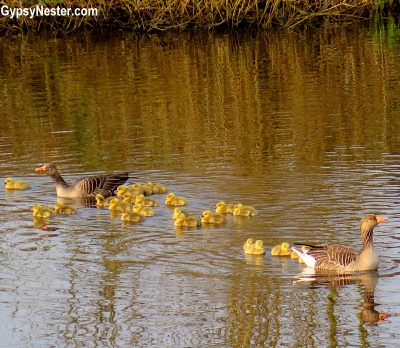
Newly hatched goslings in the Kinderdijk canals!
When the cradle was rescued, a baby was found fast asleep and perfectly dry inside.
The real origin of the name is likely a lot less inspiring, since child labor is said to have been used in the construction of the dikes.
 Willow trees are planted atop the dikes
Willow trees are planted atop the dikes
Whatever the truth behind the name, the fact is that the system holding back the water is an engineering marvel.
Over half of the Netherlands is below sea level, so pumping water is a never ending enterprise, and the Dutch have been experts at it for centuries.
That’s where the windmills come in, they are used to move water from low lying land up into the rivers, and finally out to the sea.
Yes, UP to the river! It is a strange sensation to be cruising along the river and look out at houses below the water level.
It is up to the dikes to keep the water at bay, and the windmills to pump it out.
We begin by learning about the mechanics of a mill.
The design is fairly straightforward, but nonetheless ingenious.
Our guide, Kees, shows us how the wind turns the sail blades, which turn a set of large wooden gears that transfer the motion down a huge oak pillar, which finally turns another wheel to scoop the water up and over the dike into a canal. Through a series of these canals the water is finally lifted up the level of the river.
Armed with our rudimentary knowledge, we head inside one of the nineteen working windmills in the area for a close up look at the inner workings.
We are lucky to have just enough of a breeze to fill the sails and turn the gears.
The mills also served as a home for the millers, the caretakers and operators that maintain the vital function of these flood preventing workhorses.
The one we enter once was home to a family with thirteen kids.
Maybe that’s why this is called Kinderdijk.
See more about lovely Kinderdijk!

Afternoon: A Warm Welcome (with a weird name)!
We are met back on board by the ship’s maître d’, Daniel, with a hot cup of cocoa and rum called a Tote Tante, or Dead Aunt.
The drink is a tradition in the northern part of the Netherlands known as Friesland.

Marcus, Skadi’s Hotel Manager
Stories behind the name seem to be connected to a deceased aunt being shipped home for burial from far away in a cocoa crate due to a shortage of funds.
Somehow that led to drinking chocolate and rum at the funeral.

Cruising along the canal on our way to Belgium we pass dozens of the modern version of the windmill.
These aren’t pumping water or grinding grain, they generate electricity.
They seem to line the canals for miles and miles, even along the locks that we pass through as we go upstream.

Unlike our previous Viking trips, the elevation doesn’t change very much, but we still rise a couple of feet in each of the three or four locks that we encounter today.
While we are making our way to Antwerp, we have an introduction to Belgian cuisine with the famous waffles. The Skadi’s resident pastry chef demonstrates the proper technique for preparation…

…and we demonstrate the proper technique for consumption. We also learned a little saying about food in Belgium, it is said to be cooked with French finesse, and served in German portions.
Sounds like we might just like it here.
Day Four: Antwerp – Giants, Severed Hands, Guilds and Beer
Morning: There may actually be giants!
Our day begins by entering Antwerp through the Steen, a medieval gate of the city wall.
Here we meet the first of the two legendary giants that are said to have terrorized the city through the ages, the Lange Wapper.
While tales of this shapeshifting nuisance go back as far as anyone can remember, the statue depicting him annoying two townsfolk, who look to have had a bit too much Belgian beer, was placed relatively recently in 1963.
The keystone of the gate is said to be the oldest artifact in Antwerp, a Roman fertility figure whose manhood has seriously suffered over the centuries.
In the middle ages the city placed the already ancient carving over the entrance as a show of their masculinity, but soon women were snatching bits of his endowment and feeding it to their husbands in hopes of improving their love lives.
Later the Jesuits completely castrated the poor little idol as a statement against the pagan nature of the entire ordeal. Ouch!
The Steen, which means stone, is a part of the original thirteenth century fortifications.
The name refers to the foundations, but the defenses were upgraded often up until the eighteen hundreds.
Once inside the wall we hang a right and head directly into the historic center of the city.
The first building to catch our eyes is the Vleeshuis, the Meat House, which was built in 1504 as the meeting hall for the butcher’s guild.
The claim is that the masonry was made to resemble stacks of bacon by using layers of white stones and red bricks.
We’re thinking that this is perhaps a happy coincidence and are taking that information with a grain of salt pork.
See more about our adventure in Antwerp!
Afternoon: Guilds, Severed Hands and ‘Twerps
As we move into the city center, we find that guild houses played a big part in Antwerp’s development. These groups of merchants and tradesmen met in ornate buildings surrounding the main square, and were instrumental in the politics of the city for hundreds of years.
Each building is decorated with golden statues signifying the business that the guild represented. They chose to build near the city hall because they petitioned the council for favorable rulings for their businesses.
It strikes us that these may have been early lobbyists.
 It’s not every day we see a statue chucking a severed hand!
It’s not every day we see a statue chucking a severed hand!
The square is also where we meet the second of Antwerp’s legendary giants, Antigoon.
It seems that he had the habit of extracting a toll from anyone wishing to cross the river, or cutting off the hand of those who refused and tossing it into the water.
Finally a young Roman soldier named Brabo stepped up, slayed the giant – and, in a turnabout chopped off and threw Antigoon’s hand into the river.
According to the tale, that is responsible for the city’s name from the Dutch words for hand and to throw.
Hand-Wearpan… Antwerp.
The square in front of the city hall is dominated by an enormous statue depicting Brabo standing on top of Antigoon and holding the severed hand over his head, ready to fling it into the river.
No word on whether the Roman hero called the giant a ‘Twerp while removing his appendage.
The impressive Renaissance style city hall was built as a symbol of Antwerp’s power in city’s golden age, but by the time it was completed in 1565 time was running short for this prosperity.
Ten years later Spain took over and the heyday was over.
Lucky for us, the remarkable structure survived.
Late Afternoon: An Impressive Lady
One square over, we find the Cathedral of Our Lady.
Actually, at over four hundred feet tall, we couldn’t help but see the church tower all day.
It is the tallest structure in the city, and shall remain so by law.
Beginning in 1352, construction was ended in 1521, but the church has never been officially completed.
 We adored this wonderfully playful version of the usually stoic Madonna
We adored this wonderfully playful version of the usually stoic Madonna
Walking inside, we find an unusual conglomeration of styles because the church has served as both Catholic and Protestant over the years – often suffering serious damage in the process of converting.
Restorations are continuing, and we are very pleased to find that the altarpieces, The Raising of the Cross and The Descent from the Cross by Belgium’s best-known artist, Peter Paul Rubens, have been returned to their rightful place in the cathedral.
 Loved this guy too – our guide told us that the artist didn’t know what a lion looked like. So he just jammed.
Loved this guy too – our guide told us that the artist didn’t know what a lion looked like. So he just jammed.
See more about our adventure in Antwerp!
Evening: Our Introduction to Belgium Beer. Hello Belgium Beer!
After lunch we wade deeper into the city, strolling along Meir, a broad shopping boulevard that runs from the old center to the Centraal Station.
The fantastic domed depot was constructed at the turn of the twentieth century and pays tribute to Belgium’s pioneering history of rail travel.
The country proudly claims to have had the first railroads on the European continent.
The area is also famous for diamond merchants, with about half of all of the diamonds in the world passing through at one time or another.
Needless to say, these transactions are not public, but there are certainly plenty of jewelry stores along the promenade.
After our long walk we were more interested in another of a girl’s best friends, Belgian beer.
We grab a seat on the sidewalk at The Duke of Antwerp and order a bit of one of the city’s famous brews, Martin’s pale ale.
It doesn’t take long to notice that beer is an integral part of life in Belgium.
Nearly two hundred breweries are brewing their brains out in this country that is only about the size of Maryland.
Stopping off again at the main square for a sample of two more of those brands, our waiter recommends DeKoninck as the perfect example of a local libation, and Tongerlo, which has been awarded as the best beer in the world.
We also observe that each brand of beer must be served in a glass unique to its style and name, Belgians deem this to be of prime importance, going so far as to refuse a beer if an establishment has the audacity to serve it in the wrong glassware.
We could see that the DeKoninck was properly representing Antwerp because the logo on the glass featured a detached hand. Cheers!
As far as the Tongerlo’s claim, it was very good, but we will need to do much more research on fermented beverages from around the world before we are anywhere near ready to declare a best on the planet!
See more about our adventure in Antwerp!
Day Five: Bruges – Quaint Doesn’t Even Begin to Describe Her
Morning: Roaming the town


Our next port of call, Bruges, Belgium, is no longer accessible by larger boats, so we take a short bus ride from Ghent.
Centuries ago the river was deep enough for ships and reached out to the sea, but sand deposits filled it in.
In order to keep the buses out of the historic center, we walk along ancient canals from the old city wall toward the two towers that dominate the skyline.

It is easy to see why the old town, with its outstanding preservation of medieval architecture, has been designated a UNESCO World Heritage Site.
All of the buildings, even businesses and private homes, can only be renovated according to strict rules that maintain the authenticity of the city.

Afternoon: Bless-ed Blood, and Blind Burros
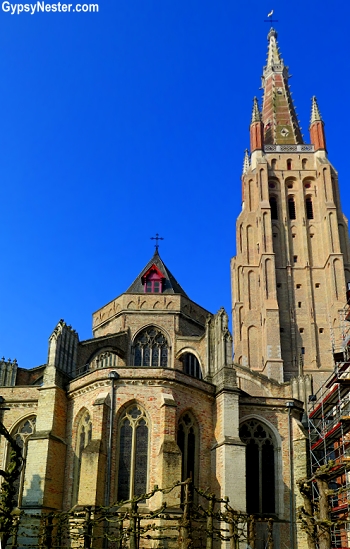
Wandering through narrow streets and small plazas, we reach the first of the towers, a brick spire over four hundred feet high, making it one of the world’s tallest made of brick.
The spire sits atop the city’s main church which, as in Antwerp, is named Church of Our Lady.
In addition to one of the world’s highest brick towers, the church is home to Michelangelo’s sculpture of the Madonna and Child.
The work wasn’t originally intended for this church, but the Italian master sold it to a couple of Belgian merchants who brought it to Bruges in 1514.


Leaving the church we turn on Blinde Ezel Straat, which we have to love because it means Blind Donkey Street, and then pass under an ornate arcade into a large square.
The archway connects the justice hall with the city hall, both of which are decorated with some serious statuary.
As is often the case, Justice holding her scales stands on the peak of the courthouse.
Next to the city hall there is a small chapel, but it looms large in the life of Bruges.
The tiny Basilica of the Holy Blood is home to the relic of the Holy Blood, reputed to be a sample of the blood of Christ. Thierry of Alsace brought the vial back from the Second Crusade.


We went in with high hopes of seeing the amazing artifact, but the relic is kept inside a silver tabernacle.
But wait, is it just wishful thinking or can we catch a peek at the vial through a sliver between the silver doors?
We’re going to say yes, we saw it.
To be certain of a view we would have to be back in town for the annual procession through the streets celebrated on Ascension Day, which is forty days after Easter, and is always one of the city’s biggest events.
Afternoon: Don’t Call Them French Fries!

The second of the two famous towers of Bruges, the Belfort, looms over us and we walk over to the next plaza where Markt, or Market, Square opens up below the belfry.
Opposite the tower a row of restaurants awaits, so we make our way over for a midday meal.
Lunch offers a good opportunity for us to delve deeper into our beer research.
Bruges, is every bit as soaked in beer heritage as Antwerp, and to fortify ourselves for a climb up the three hundred and sixty-six steps to the top of the town’s famous bell tower we will need some tradition Belgian food and of course, beer.

The history of brewing in Belgium goes back nearly a thousand years. Originally monks made beer, and some still do, but the art has become an integral part of Belgian life.
Being ignorant in the ways of the country’s brews, we once again rely on our waiter to recommend the ultimate local beverages.
A Zot blond is pretty much a must in Bruges, and we passed the brewery walking into town, so that was one, the other, a Kwak, came with the server’s endorsement as “a special beer.”
Judging by how it arrived, the Kwak is indeed special.
See more about our adventure in Bruges!
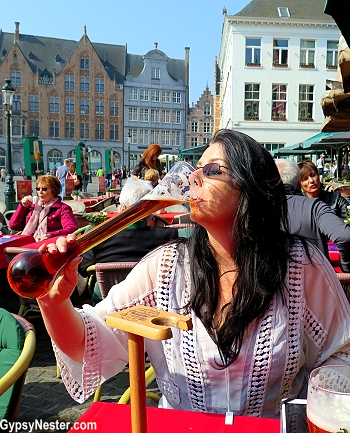
The giant bulb glass with a wooden stand makes the entire presentation quite a show.
Nearby tables were snapping pictures, and we must say, the taste lives up to the hype.
To pair with the beers we go for two of Belgium’s most typical dishes, mussels with French fries, and a creamy chicken stew known as waterzooi, which is often made with fish.
Oops, we must correct ourselves, never call fried potatoes “French” in Belgium.


Fries are without a doubt the national food, and they claim to have invented them.
The French tag was supposedly due to mistaken identity by US GIs during World War I. Little shops that serve paper cones filled with fries are everywhere, and proper consumption requires choosing a sauce.
Mayonnaise is generally the default option, but any good fry shop will have about a dozen more flavors to pick from.
Late Afternoon: A Steep Climb and a Giant Music Box… We’re not done yet! Continue along with us…
David & Veronica, GypsyNester.com
Written aboard the Longship Skadi on her voyage through Holland and Belgium with stops in Amsterdam, Kinderdijk, Antwerp, Bruges, Veere, Hoorn, and Arnhem. Thanks to Viking River Cruises for inviting us along and providing this adventure! As always, all opinions are our own.






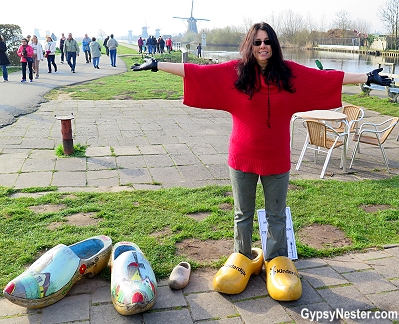




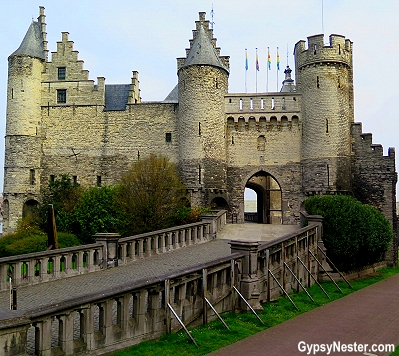

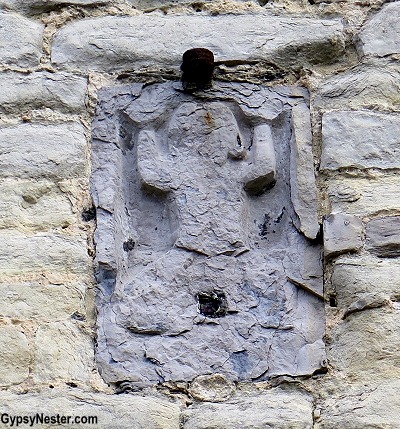










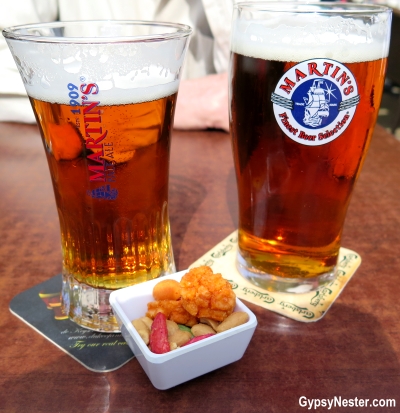


“Quaint” is the perfect word for Bruges. Hope you both had a blast exploring Belgium!
We did Mary, thanks!
i was helping a friend who opened her house to one of the groups !!! And we enjoyed this very much …I enjoyed having conversations with the many people who came to the house .As i am a American living in Holland .i had a great time meeting lots of nice people .Cees and Jet de Boer were the host and did a great Job … I am happy to read that the American and Canadian people liked the idee of coming into a regular Dutch home for a visit …. And i enjoyed helping my friend with it ….
It is really great that so many people are opening their homes like this. We loved meeting Steef and Lia. Thanks for helping with this project.
Man, the Netherlands looks like such an amazing place … food, architecture, tulips – it has everything for proper living!
Well put Frank, we agree.
Belgium and the Netherlands are so cultured in just about every way … loving the pictures!
Thanks Elaine!
I am also a hostess from Hoorn receives tourists from Viking with coffee or tea. Also I am very excited about this way of communis honor with tourists in our city. Every day I enjoy this time and also the tourists see this as a highlight of their trip. Thanks for reading this nice blog.
Sincerely Ellis Bosch
Great to hear from you, thanks for commenting. Our visit truly was one of the highlights of our trip.
A journey through the art and history of Amsterdam…enjoyed it…
We just returned from Amsterdam and took a tour of the Six house. Look it up for your next trip to Amsterdam. Amazing private collection of art.
Thanks Art, we’ll check it out.
Sounds like an amazing time. Love all the pictures.
Thanks Judy, it has been.
Oh my god, your post reminded me of when we were at the church of the holy blood and they had the veneration ceremony. http://www.acooknotmad.com/2011/09/battered-and-brugged.html
Wow, you got to see it! We are very jealous. Thanks for the link.
Yummm! I could practically taste the Kwak going down. Hubs and I lived in Belgium for 6 months and we miss it every day. So glad you’re experiencing it.
~S
You might even say it was a Kwak attack! 😉
Love Holland and love Viking River Cruises. Like you, I was fortunate to experience the Christmas markets on the Danube. What a trip!
We do too.
https://www.gypsynester.com/christmas-cruise.htm
It was great!
We have a tulip cruise schedule for the end of the month. You have really whet my appetite!
Glad we could Irene, have a great trip!
Hey, which ship are you on? What is your departure date? Would be interesting if you are on the same one as us. Leaving on the Magni on the 24th.
Sorry to miss you. We are on Skadi, left April 5 and finish on the 15th.
I was thinking maybe Irene Levine might be on our trip.
We are there in 10 days. Any advice? Any tips? Love reading your blog. Might have to do one too. Checked Anne Frank’s house,Meyer, all booked thru May. Hoping concierge at hotel can help get tickets.
Hope they can help too because it is really worth a look. Otherwise, our advice is to enjoy your trip, it’s fantastic.
Enjoying reading your blog. Hope our trip is as exciting. We are supposed to be there in time to see the Flower Parade on the last Saturday of April, the 24th. Ship leaves at night so should work out. I hope!
Should be great!
Amazing how a crazy tale about severed hands ends up being a primary symbol of a place. Hand weapon = Antwerp. Who knew?
They really seem to have embraced it.
This cruise looks like so much fun. I love the photos of Amsterdam. It’s been a long time since I’ve been there – this makes me want to go back.
Nice read. Love the pics and the video.
Thanks Laura!
My favorite part of your post is the newly hatched goslings and the willow trees. My maiden name, Terwilliger, is Dutch and means by the willow trees (in Holland). I haven’t seen that area yet but I have visited Amsterdam several times and seen all the wonderful sights there. LOVE tulip time. For you, http://berkeleyandbeyond.com/Way-Beyond/Travel-Articles/Abroad/Tulip-Time/tulip-time.html
Very fun about your maiden name Carole. Thanks for the link.
I enjoyed visiting Amsterdam many years ago, a beautiful city with a laid back vibe.
We’re still waiting for the first spring buds here in Philly. I’ve been lots of places (42 countries by my count—but we’re not supposed to count, right?) However, a major impossible to miss gap in my travel resume is The Netherlands! I know it’s a small country, but seriously, how can I have missed it?
Spring seems to be arriving here. Holland is certainly worth a visit, very unique.
Oh how I enjoyed your great shots of beautiful Amsterdam! One of our favorite cities…I’m always eager to return!
We are always glad to come back ourselves.
Yum! The food on your Viking cruise looks amazing. I’d love to explore Amsterdam this way.
I kept looking at the buildings wondering whether it was me, but they do slant every which way. You are seeing some of my favourite places. Enjoy.
They really do go every which way… it’s crazy!
Wow, this looks fabulous! And I love the crooked houses! What fun to take this wonderful cruise.
Sounds like a fabulous way to kick off spring 2015. Hope the tulips in Holland are splendid. Enjoy your cruise.
Thanks Judy! Seems like a great way to welcome the new season.